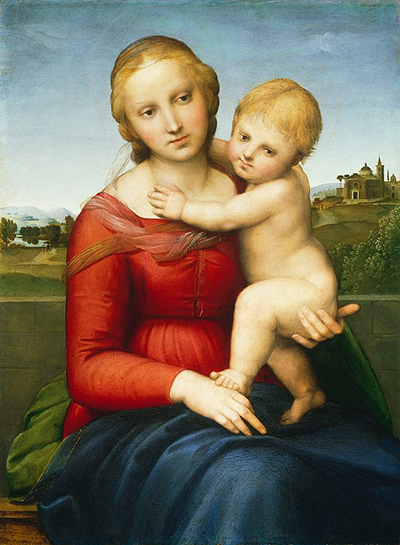The Small Cowper Madonna is a sketch by the famous Italian High Renaissance craftsman Raphael, portraying Mary and Child, in a regular Italian field. It has been dated to around 1505, the centre of the High Renaissance.
This depiction, known as the Small Cowper Madonna since it was the littler of the two Raphael Madonna works of art claimed by the English gatherer Lord Cowper, was painted when the craftsman was around twenty-two. It uncovers not just the substantial impact of his Umbrian ace, Perugino, yet also that of his Florentine adversaries, Leonardo and Michelangelo.
The Small Cowper Madonna painting is a more expository variation of the homogeneous and undaunted gathering of the Madonna del Granduca. Here, the artist communicates the impact of Leonardo in an expansive, delicate scene. This scene contains a little church with a round and hollow vault, which might be a reference to Bramante's design; the painting could be the Franciscan religious community of San Bernardino close to Raphael's local city of Urbino.
Sitting in the focal point of the work in a brilliant red dress is the Madonna. She is reasonably cleaned with blonde hair. She sits comfortably on a wooden seat. Over her lap is a dark drapery after that her right hand gently rests. There gives off an impression of being a sheer translucent strip carefully streaming over the highest point of her dress and behind her head. The faintest brilliant corona inexplicably encompasses her head.
In Madonna's left hand she holds the infant Christ, who grasps her with one arm across her back, and the other across her neck. He, a valuable youngster, thinks back behind him with a hesitant grin. Behind them, a flawlessly clear and splendid day unfurls. Off out yonder two figures have all the earmarks of being wandering toward a deep lake, getting a charge out of the green view around them. An extensive and extremely awing structure remains toward the finish of a long way, which one could dare to be a Catholic church. Its vault and other auxiliary components regular of Catholic design add to the effectively inescapable air of religious godliness and elegance.
It isn't known precisely why the Small Madonna was painted in the first place. It was most likely either a private commission or for the entire artistry showcase; pictures of the Madonna and Child were frequently given as wedding gifts. It is broadly felt that the congregation on the right-hand side of the artistic creation is the congregation of San Bernardino, where formerly the Dukes of Urbino were covered, and it has been recommended that the nearness of the group implies the sketch may have been "dispatched by the family for reverential purposes." In the meantime, it could merely be Raphael drawing on recollections of the congregation, which could have been close where he experienced childhood in Urbino.
Raphael would surely be amazed to discover that his image has come to be called the Small Cowper Madonna. Going through the hands of a progression of gatherers in the hundreds of years after their creation, artistic creations regularly gained the name of a later proprietor. In the 19th Century, this painting and another one, Madonna and Child by Raphael was currently known as "The Large Cowper Madonna" were among the fortunes of the craftsmanship gathering of Earl Cowper, a British noble. It has been referred to as far back as "The Small Cowper Madonna."




